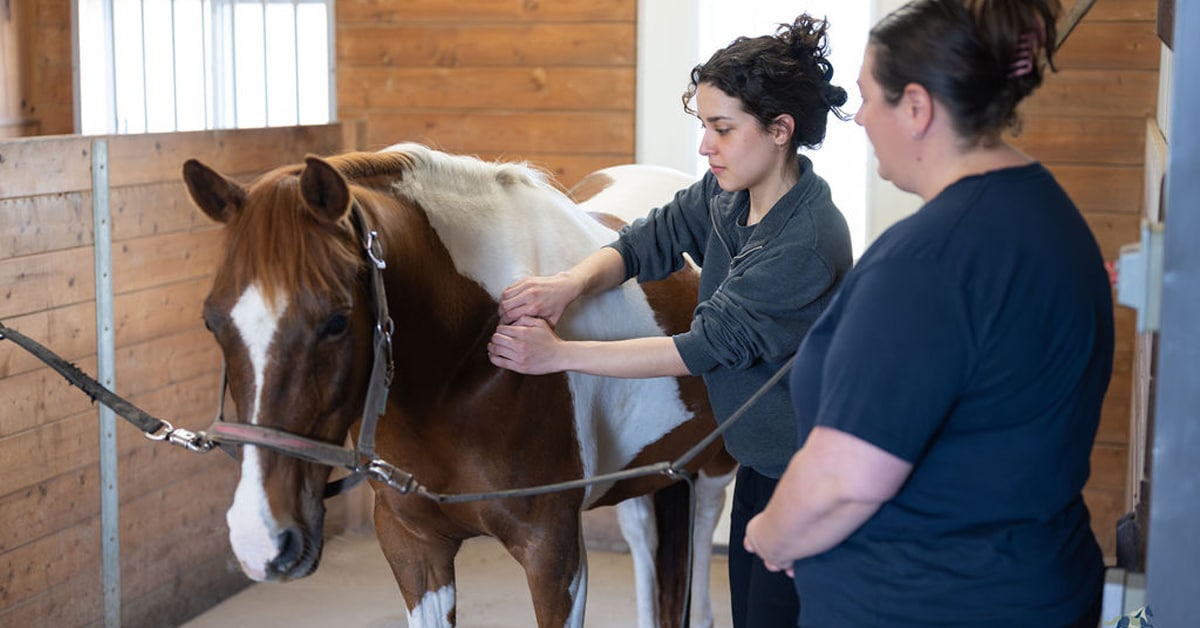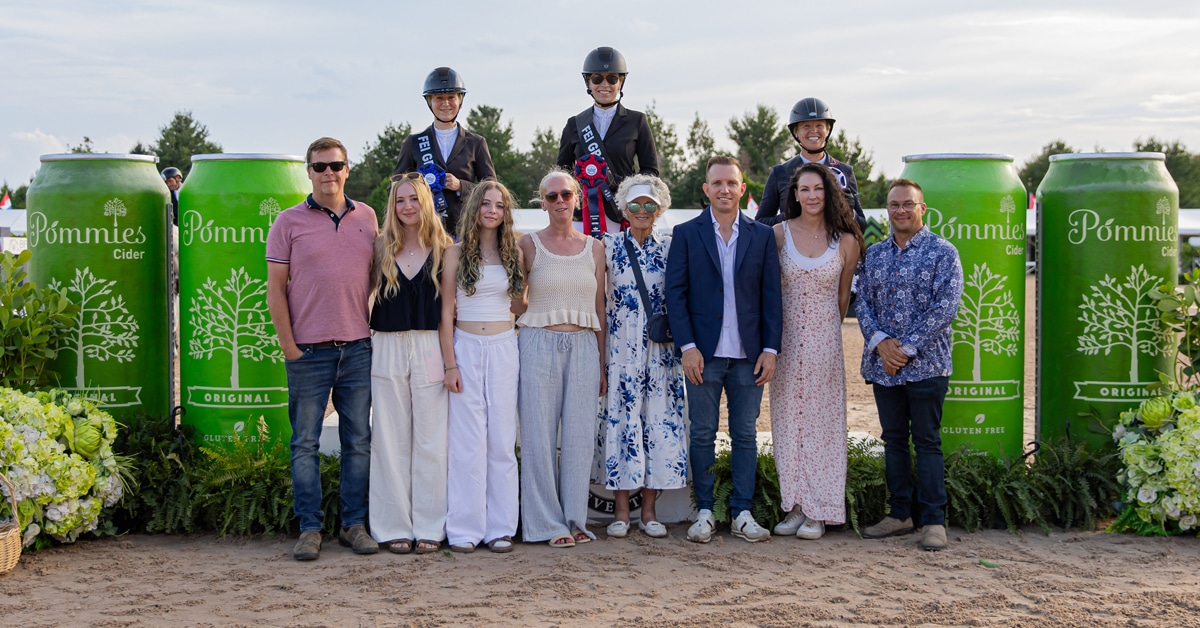The Westphalian gelding owned by Mark Harryman was inspected by multiple veterinarians, although none held out much hope the horse could be saved, let alone return to the grand prix circuit. At the suggestion of a friend, Brown, who resides in Menlo Park, CA, decided to try a treatment that had recently emerged, but had yet to garner headlines on this continent.
“I went over what my vets said, then threw it all out and made a decision on my own,” he said. “This treatment was recommended by a friend in New Zealand. He said it was cutting-edge and explained to me how it worked. Within a week Dr. Patrick Casey flew out here, looked at the horse and told me he thought he could fix it, which was a lot more than what other veterinarians were telling me.”
Casey, a veterinarian and research specialist from New Zealand, removed about 100 tenocytes (tendon cells) from a ligament in Angelli’s neck via a special spring-loaded biopsy method while the horse was under general anesthesia. These cells were cultured for three weeks, then collected and reinjected into Angelli’s tendon lesion.”His tendon was essentially shredded and was quite damaged,” Casey remembered. “But the tear was fresh enough to give it a go.”
Following an extended period of stall rest and hand-walking the horse not only returned to work, but regained his prior top form. Angelli was third in last year’s $30,000 June Classic III Grand Prix in San Juan Capistrano, CA, and was under consideration to compete in the Olympic trials.
“He was back in the ring in eight months and in a little over a year we were back in business,” Brown said. “We could have taken him to London, but I chose to use another one of my horses. He’s out with an injury now, but it has nothing to do with his tendon. I would recommend this treatment, and in fact used it on another one of my horses who just returned to competition this morning (February 8). Patrick Casey is an absolutely brilliant man.”
Tricky tendons
Tendons are primarily composed of durable, elastic collagen fibres that are packed tightly together. They connect muscles to bones and absorb some of the stress placed on a horse’s musculoskeletal system. In most instances, they can stretch as much as three to five times their original length, but if the tendons elongate beyond 8-12 per cent, the fibres tear instead of snapping back into place.
The superficial digital flexor tendons (SDFT) in a horse’s front legs are injured the most frequently. The SDFT traverses the length of the cannon bone from the knee or hock to the coffin bone and is the closest structure to the skin. Since the SDFT protects only a very small location behind the mid-cannon bone, that area often sustains damage. A rupture or strain, however, can emerge anywhere along the tendon.
Any horse can suffer from a tendon injury, but some are in greater jeopardy. Risk factors include age, level of fitness, poor conformation, gender, and the type of activity being performed. Damaged tendons are notoriously tricky to repair, because a horse lacks musculature below the knee and there is not enough blood flow to promote quality healing. Also, the torn tissue is replaced by scar tissue instead of regenerating new collagen fibres, so there is reduced elasticity.
It is estimated that more than 30 per cent of all sport horses in Canada, the US, and the UK will sustain some sort of tendon injury during their career. Over the last several decades, medical technology has made large strides, yet only 20-30 per cent of horses that injure their tendons ever return to their prior form, and normally only after at least six to 12 months of rehabilitation. Even if a horse does successfully return to competition, there is close to an 80 per cent chance he’ll back in the barn with another injury to the same tendon in short order.
Growing tendon tissue
The best news about tendon injuries is that there are now many therapies and treatment options available, such as platelet-rich plasma (PRP), stem cell therapy, bone marrow aspirate concentrate (BMC), extracorporeal shock wave therapy, tendon splitting, and plantar fasciotomy and neurectomy. The current veterinary trend is to use these treatments in conjunction with each other to assure the tendon will be restored to its prior state. “The emphasis with most of these therapies is regeneration rather than repair,” Dr. Linda Dahlgren of the Virginia-Maryland Regional College of Veterinary Medicine told The Horse. “Repair means scar tissue, which is neither as strong nor as elastic as the original structure. We’re trying to provide the ingredients for the tendon or ligament to build the right kind of matrix, so that the healed cells are indistinguishable from the original ones.”
“For instance, PRP supplies concentrated growth factors and signaling proteins, which are beneficial in healing,” she continued. “But it also contains a protein matrix which can become a scaffold for the new cells. They adhere to the scaffold and get some instruction as to what to do. BMC and PRP together, or PRP plus stem cells, can increase your chance of good regenerated tissue.”
Casey’s technique – known as tendon transplanting or tendon regeneration – is certainly an extremely viable choice. It’s costly (around $20,000) and not as easily accessible as some of the other treatments, but it has enjoyed a fairly high level of success in the more than 60 horses treated since it burst onto the scene nearly seven years ago. After more than eight years of research and collaboration between Casey, Dr. Richard Fry, an associate professor at the University of Melboure in Australia, Dr. James Vanner of Geelong Veterinary Hospital in Victoria, AUS, and the now deceased professor Mont Liggins of the University of Auckland (NZL), the group launched their first clinical trials in 2006. “We all started thinking how we could get a single cell to restart or regenerate itself,” Casey said.
After the tenocytes are removed from the horse, they are brought to the lab and hung upside down in a sealed container for two days before shifting them to a horizontal position for two to three weeks. Following this process, the cells began to divide and are treated with trypsin, which is a serine protease secreted by the pancreas. (Serine proteases are digestive enzymes involved in normal bodily functions such as digestion and aid in the breakdown of protein molecules.) Once they have morphed into roughly 16 million tenocytes, the cells are then ready to be harvested and reinjected into the tendon tear.
Successful cases and hope
In 2006, the procedure was conducted on Australian trotter Calder Sensation when the gelding sustained an extremely severe suspensory injury. Casey did not have much confidence their work would have much of an effect on the horse’s situation, as he was treated more than four months after he was hurt and the damage was so significant it was recommended the owner might have to put the horse down. “All three tendon branches below the fetlock had significant tears,” Casey said. “It was a very serious situation and you need to get in there before the scar tissue starts to grow. We ultrasounded it and saw the lesions had not begun to fill in, so we thought we would at least give it a try to see what would happen.”
Calder Sensation was injected and spent nine months in his stall, and was not cleared to even return to walking until Casey confirmed through continual ultrasounds that the lesion had completely filled. Seventeen months later, Calder Sensation won his first race back at the Moonee Valley track in Australia.
Casey and his group developed a company called Therapy Cells Ltd. (www.therapycells.com) which began to appear in international headlines. They have since successfully treated horses all over the world, including the Trakehner mare Monique, who was on the New Zealand Elite B Dressage team from 2004-2008 and competed in grand prix competition in 2008 with owner/rider Angela Fergusson. Casey also treated 2007 Breeders Crown victor Artist’s View. The pacing stallion retired last June after earning more than $400,000 following his recovery.
“There truly is no difference between treating race horses, sport horses, hunter-jumpers or even barrel racers,” Casey said. “Nearly all performance horses develop the same type of tendon injuries and recovery times are virtually alike all across the board. I have treated more than 60 horses, all from different disciplines, and 85 per cent have recovered to return to their prior level. I would have to say it’s not in what sport the horse competes, but how severe the tendon damage is and how soon we are able to treat it that influences the healing of the injured tendon.”
Casey was recently granted a patent by the US Food and Drug Administration to conduct further studies to be applied to human medicine. Currently, he is working on a clinical trial for regenerating human skin for burn victims or scar tissue damage, but eventually hopes to apply his technique to Achilles tendon and rotator cuff injuries. “This could completely alter the field and what methods are employed,” he said. “Imagine how many lives could be entirely changed by this work.”
For horse owners, Casey warns that tendon transplants are not a panacea for all tendon injuries and acknowledges more research must be completed in order to cause the newly-formed tenocytes to remain in the lesion without gravitating to other areas of the body. “This treatment could definitely revolutionize how tendon injuries are treated, but it is not a miracle cure,” he said. “There will always be some tendon injuries that simply cannot be repaired, but I think this method could have a very brilliant future.”
The Latest









